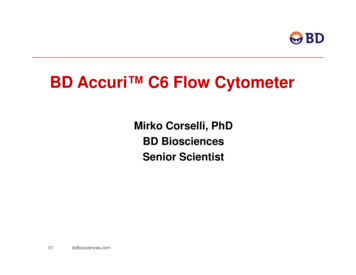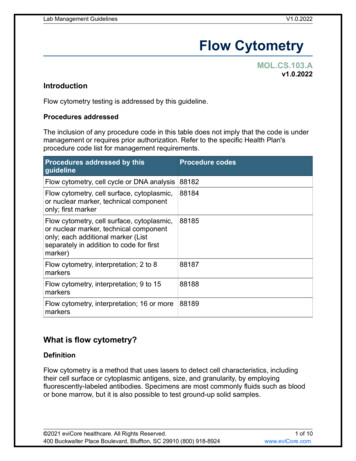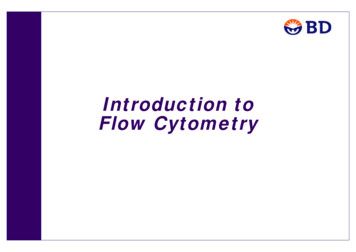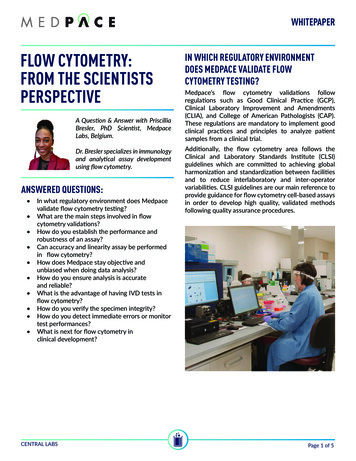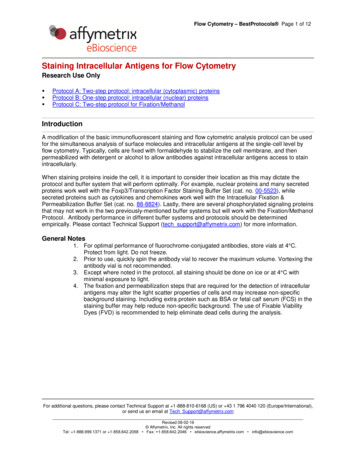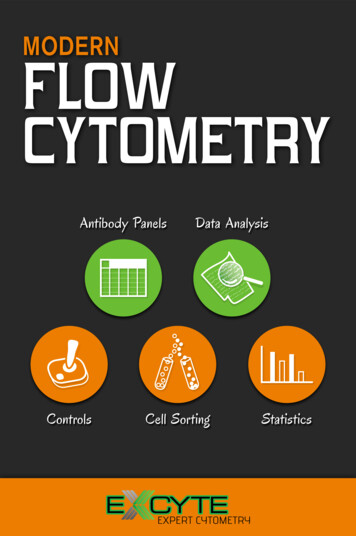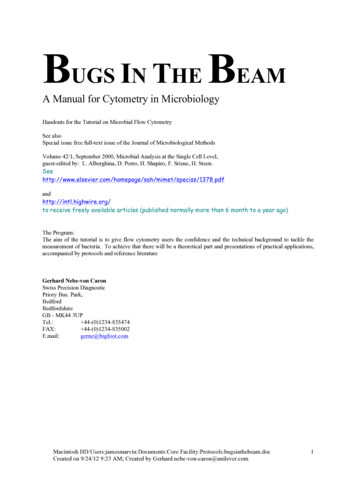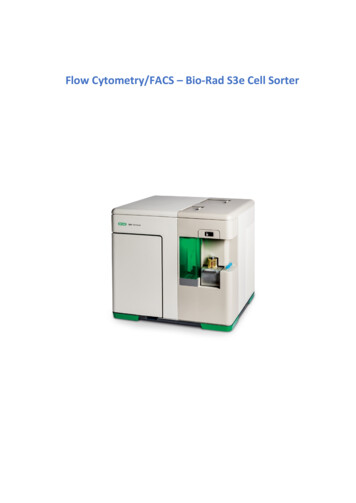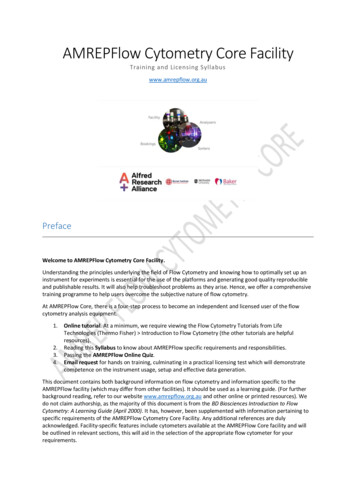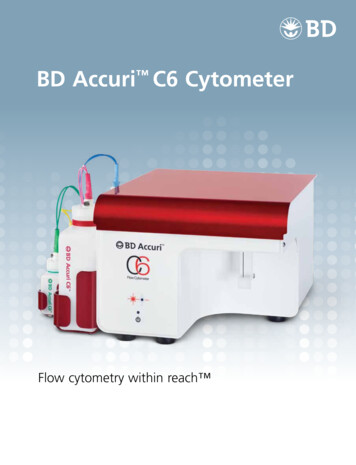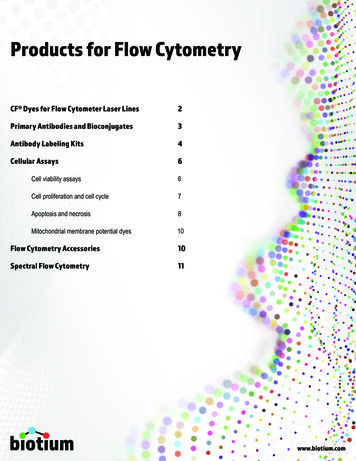
Transcription
Products for Flow CytometryCF Dyes for Flow Cytometer Laser Lines2Primary Antibodies and Bioconjugates3Antibody Labeling Kits 4Cellular Assays 6Cell viability assays 6Cell proliferation and cell cycle7Apoptosis and necrosis 8Mitochondrial membrane potential dyes10Flow Cytometry Accessories 10Spectral Flow Cytometry 11www.biotium.com
Flow Cytometry Laser Lines for CF DyesLaser LineUV (355 nm)Visible spectrumViolet (405 nm)Blue (488 nm)Blue (488 nm),Green (532 nm)Blue (488 nm),Green (532 nm),Yellow (561-568 nm)Near-infraredFar-redGreen (532 nm),Yellow (561-568 nm)Red (633-647 nm)CF DyeλEx (nm)λEm (nm)Spectrally similar toAdvantagesCF 350347448Alexa Fluor 350, AMCA,DyLight 350Alexa Fluor 405, CascadeBlue , DyLight 405BD Horizon V450,eFluor 450, Pacific Blue Brightest blue fluorescent conjugates for 350 nm excitation Highly water soluble and pH-insensitive Better compatibility with common instruments Highly water soluble and pH-insensitive More photostable and less spill over in the 525/50 green channel than PacificBlue dyeCF 405S404431CF 405M408452CF 405L395545Pacific Orange Long stokes shift allows multicolor detection from violet laser excitationCF 430426498Pacific Green CF 440440515Alexa Fluor 430 More photostable than spectrally similar dyes Compatible with AmCyan channelCF 450450538Unique spectral properties 405 nm-excitable green dye with unique spectral properties Yields more specific antibody conjugates and less spill over fluorescence inthe red channel than Alexa Fluor 488 Extremely photostable, highly water soluble, and pH-insensitiveCF 488A490515Alexa Fluor 488, Cy 2,DyLight 488, FAM, FITC,FluoresceinCF 503R503532ATTO 488CF 514516548Alexa Fluor 514CF 532527558Alexa Fluor 532, ATTO 532 Significantly brighter than Alexa Fluor 532 Significantly brighter than Alexa Fluor 546 Highly water soluble and pH-insensitive Alternative green dye for multispectral detection or FRET Green dye that can be distinguished from CF 488A by spectral unmixing Extremely photostable, highly water soluble, and pH-insensitiveCF 543541560Alexa Fluor 546,Tetramethylrhodamine (TAMRA)CF 550R551577Unique spectraCF 555555565Alexa Fluor 555, ATTO 550,Cy 3, DyLight 549, TRITC Brighter than Cy 3 Comparable to Alexa Fluor 555CF 568562583CF 570568591Alexa Fluor 568, ATTO 565,Rhodamine Red Optimized for the 568 nm line of the Ar-Kr mixed-gas laser Brighter and more photostable than Alexa Fluor 568CF 583583606Cy 3.5, Texas Red CF 583R586609Cy 3.5, Texas Red CF 594593614Alexa Fluor 594, ATTO 594,DyLight 594CF 620R617639LightCycler Red 640Alexa Fluor 633, Alexa Fluor 647, Cy 5, DyLight 633Alexa Fluor 647, ATTO 647N,Cy 5, DyLight 649Alexa Fluor 647, Cy 5,DyLight 649 Orange/red dye ideal for multispectral detection or FRET Less background than Cy 3.5 and Texas Red Ideal for FRET when paired with R-PE Brighter than Cy 3.5 and Texas Red Ideal for FRET when paired with R-PE Yields the brightest conjugates among spectrally similar dyes Extremely photostable Highly fluorescent, highly water soluble, and extremely photostable Yields the brightest antibody conjugates among spectrally similar dyes Far more photostable than Alexa Fluor 647 Has the best photostability among dyes with Cy 5-like spectra Highly fluorescent, highly water soluble, and pH-insensitive Brighter than Cy 5 Highly water soluble and pH-insensitive Much brighter and more photostable than Alexa Fluor 660 Highly water soluble and pH-insensitiveCF 633630650CF 640R642662CF 647650665CF 660C667685Alexa Fluor 660CF 660R663682Alexa Fluor 660 The brightest among spectrally similar 680 nm dyes Superior signal-to-noise ratio in immunostaining Highly water soluble and pH-insensitive Compatible with LI-COR Odyssey System The most photostable 680 nm dye Suitable for labeling nucleic acids and small biomolecules Highly water soluble and pH-insensitive Compatible with LI-COR Odyssey System Brighter than Alexa Fluor 660 The most photostable 660 nm dye Highly water soluble and pH-insensitiveCF 680681698Alexa Fluor 680, Cy 5.5,DyLight 680, IRDye 680LTCF 680R680701Alexa Fluor 680, Cy 5.5,DyLight 680, IRDye 680LTCF 700695700Alexa Fluor 700, DyLight 700 Exceptionally bright and stable Patented PEGDye dye for superior performance Exceptionally bright and stable Highly water soluble without bearing excessive charge Better signal-to-noise ratio compared to APC-Alexa Fluor 750 tandem dyewith 633 nm excitationCF 750755777Alexa Fluor 750, Cy 7,DyLight 750, IRDye 750APC-Alexa Fluor 750CF 770770797DyLight 800, IRDye 800CWCF 790784806Alexa Fluor 790Near-IR (785-808 nm)CF 800797816Indocyanine GreenCF 820822835DY-820 Exceptionally bright and stable Highly water soluble without bearing excessive charge Superior signal-to-noise for conjugates Compatible with LI-COR Odyssey SystemAlexa Fluor, Cascade Blue, Pacific Blue, Pacific Green, DyLight and Texas Red are registered trademarks of Thermo Fisher; ATTO dyes are products of ATTO-TEC GmbH; BD Horizon is a trademark of BD Biosciences; Cy is a registered trademark of GEHealthcare; eFluor is a registered trademark of eBioscience; IRDye and Odyssey are a registered trademark of LI-COR Bioscience; LightCycler is a registered trademark of Roche Applied Science.2 www.biotium.com
Primary Antibodies and Other BioconjugatesBiotium offers a wide selection of primary antibodies and biomolecules conjugated to our bright and photostable CF Dyes, as well as R-phycoerythrin (R-PE),allophyocyanin (APC), PerCP, and biotin. Visit www.biotium.com for a full listing of fluorescent conjugates for flow cytometry.Growing selection of over 1000 mAbsPrimary Antibody Sizes and FormatsFormatConcentrationSize Comprehensive library of recombinant monoclonal mouse andrabbit antibodiesCF Dye conjugates (13 colors)0.1 mg/mL100 or 500 uL Choice of 13 bright and photostable CF DyesBiotin, HRP, or AP conjugates0.1 mg/mL100 or 500 uLR-PE, APC, or PerCP conjugates0.1 mg/mL250 uL Other fluorophores available including R-PE, APC, PerCP, HRP,AP, or BiotinPurified, with BSA0.2 mg/mL100 or 500 uL Isotype control antibodies available conjugated to the same dyesand labelsPurified, BSA-free (Mix-n-Stain Ready)1 mg/mL50 uL BSA-free purified antibodies ready to use for Mix-n-Stain labelingAnti-Tag and Anti-Hapten AntibodiesMouse Monoclonal Anti-GFPRabbit Anti-RFPRabbit Anti-GSTRabbit Anti-HA TagMouse Monoclonal Anti-6X His TagRabbit Anti-Myc TagRabbit Anti-V5 TagRabbit Anti-FLAG TagMouse Monoclonal Anti-BiotinMouse Monoclonal Anti-FluoresceinApplicationAnnexin VApoptosis (phosphatidylserine) detection (see p. 9)Dextrans & BSAFluid phase endocytosis tracerStreptavidinDetection of biotinylated probesBiotinBiotinylated probes, and biotinCountFigure 1. HeLa cells stained with CF 555monoclonal anti-nucleolin (clone 364-5) (red),CF 488A phalloidin (green), and Hoechst (blue).Other BioconjugatesLooking for another conjugation?APC-AFigure 2. Surface staining of human PBMC withCD4 (EDU-2) CF 640R conjugate (magenta)compared to unstained cells (gray).If you are looking for a product not listed on our website, please contacttechsupport@biotium.com and let us know. We may be able to add itas a new product, or perform a custom conjugation for you.www.biotium.com 3
Antibody Labeling KitsMix-n-Stain Antibody Labeling KitsMix-n-Stain antibody labeling kits dramatically simplify the process ofpreparing fluorescently-labeled antibodies. Simply mix your antibody with thereaction buffer and desired fluorophore provided with the kit. The resultingconjugates offer comparable performance to commercially availablepre-labeled antibodies (Fig. 1). Because the labeling is covalent, theconjugates are stable for long-term storage, and ideal for multi-color imagingand multiplex flow cytometry.Mix-n-Stain kits feature Biotium’s CF Dyes, which have advantages inbrightness and photostability compared to other fluorescent dyes. A variety ofother labels are also available.Mix-n-Stain Advantages Rapid and efficient labeling with minimal hands-on time Available with 29 CF Dyes, R-PE, APC, PerCP, or tandem dyes Other label options: Biotin & FITC, HRP, AP, and GOx 100% yield with no purification required Labeling tolerates BSA, gelatin, ascites fluid, and Tris Kits available for labeling as little as 1 ug and up to 1 mg of IgGantibody Labeling kits for nanobodies also availableWe also offer Mix-n-Stain Nanobody Labeling Kits which allows rapid andoptimal labeling of single-chain nanobodies with CF Dyes or biotin without apurification step.Competitor KitMix-n-Stain APCMix-n-Stain kits are also available in a maxi size for labeling up to 1 mg ofIgG antibody with CF Dyes or other dyes. See the tables on page 5 for acomplete listing of available Mix-n-Stain Antibody Labeling Kits.30 minhands-freereaction30 min hands-freereactiontime timeMix antibody, buffer, and pre-measureddyepre-measured dyeMix antibody,buffer, andLabeled antibody readyAPC-AAPC-AFigure 1. An anti-mouse antibody was labeled with APC using either the Mix-n-Stain APC Labeling Kit, or a competitor’s APC labeling kit. The antibodies were used to stainJurkat cells that had been incubated with or without mouse anti-CD3 primary antibody. TheMix-n-Stain labeled antibody showed no background on no-primary control cells (pink)but a strong signal on CD3-labeled cells (blue).for stainingLabeled antibodyready for stainingOverview of CF Dye Mix-n-Stain labeling protocol; Mix-n-Stain protocols vary forfluorescent proteins (ie, R-PE, APC), tandem dyes, and enzymes.CF Dye SE Protein Labeling KitsCF Dye SE Protein Labeling kits allow you to label your antibody of interestwith one of our many bright and photostable CF Dyes or biotin. Thedifference is that while the Mix-n-Stain kits come optimized for fast andconsistent labeling of small amounts of antibody, the SE Protein LabelingKits are designed for 3 labelings of up to 1 mg protein with removal of freedye after labeling. The kits also allows the user to adjust the amount of dyeand protein to optimize the degree of labeling. See the tables on page 5 for acomplete listing of available SE protein labeling kits.CF Dye SE Protein Labeling Kit Features Kits that allow more flexibility for labeling optimization Choice of 19 CF Dye colors or biotin Includes reagents for 3 x 1 mg labeling reactions with purification Includes instructions for determining the degree of labeling (DOL)CF Dyes and Mix-n-Stain antibody labeling technology are covered by granted and pending U.S. and international patents.We welcome inquiries about licensing the use of our dyes, trademarks or technologies. Please submit inquiries by e-mail to btinfo@biotium.com.4 www.biotium.com
Antibody Labeling KitsAntibody Labeling KitsDyeEx/Em (nm)SE labelingCF 350CF 405LCF 405MCF 405SCF 430CF 440CF 450CF 488ACF 514CF 532CF 543CF 555CF 568CF 570CF 583CF 594CF 633CF 640RCF 647CF 660CCF 660RCF 680CF 680RCF 700CF 750CF 770CF 790CF 800CF 2Mix-n-Stain Nanobody 5-20 ugMix-n-Stain Nanobody20-50 -n-Stain 5-20 ugMix-n-Stain 20-50 ugMix-n-Stain 50-100 ugMix-n-Stain Maxi 1 0992410924229242392424Labeling Kits for Other ConjugatesConjugateEx/Em (nm)BiotinSElabelingMix-n-Stain 5-20 ugMix-n-Stain 20-50 ugMix-n-Stain 25-50 ugMix-n-Stain 50-100 ug92224922869226692244922949229592296Mix-n-Stain Maxi 1 mgFITC494/518R-PE496, 546, 230892309Cyanine 555555/56592412924139241492415Cyanine 647650/66592416924179241892419RPE-CF 647T496/665923409234192346APC-CF 750T650/7809231092311Mix-n-Stain Nanobody5-20 ugMix-n-Stain Nanobody20-50 ug925009250192411Cy is a registered trademark of GE Healthcare.www.biotium.com 5
Cell Viability AssaysLive-or-Dye Fixable Viability StainsLive-or-Dye Fixable Viability Staining Kits are cell membrane-impermeant amine-reactive dyesdesigned for highly specific discrimination between live and dead cells during flow cytometry andmicroscopy. The staining is extremely stable, allowing cells to be fixed and permeabilized withoutloss of signal or dye transfer between cells.Biotium offers a selection of 14 different Live-or-Dye viability stains spanning the fluorescencespectrum. (Fig. 1). Live-or-Dye NucFix Red is a unique, cell membrane-impermeant dye thatspecifically stains the nuclei of dead cells. NucFix labeling is extremely stable, allowing thecells to be fixed and permeabilized without loss of fluorescence or dye transfer between cells.Live-or-Dye Advantages Offers the most available colors Dye options designed for spectral flow Highly dead cell selective Withstands fixation and permeabilization Stable in solution for at least a year Covalent labeling with reactive dyesLive-or-Dye KitsFigure 1. Jurkat cells were either left untreated or killed by heating to 56 C for 45 minutes, then stained withLive-or-Dye cell stain shown on each histogram x-axis. Heat killed cells (solid peaks) showed much higher fluorescenceintensity compared to live cells (white peaks), allowing the two populations to be clearly distinguished.Calcein AM Cell Viability AssayCalcein AM is a non-fluorescent, membrane-permeant compound. Esteraseactivity in the cytoplasm of viable cells converts Calcein AM to the greenfluorescent, membrane-impermeant compound calcein, which is retained inviable cells with intact plasma membranes (Fig. 2). The Viability/CytotoxicityAssay Kit for Animal Live & Dead Cells pairs Calcein AM with the redfluorescent vital dye Ethidium Homodimer III for quantitation of live anddead cells.ProductEx/Em(nm)Cat. No.50 RxnsCat. No.200 RxnsLive-or-Dye 350/448347/44832002-T32002Live-or-Dye 375/600*375/59532014-T32014Live-or-Dye 405/452408/45232003-T32003Live-or-Dye 405/545395/54532009-T32009Live-or-Dye 510/550*516/54932012-T32012Live-or-Dye 488/515490/51532004-T32004Live-or-Dye 568/583562/58332005-T32005Live-or-Dye 594/614593/61432006-T32006Live-or-Dye 615/740*674/81332015-T32015Live-or-Dye 640/662642/66232007-T32007Live-or-Dye 665/685*667/68532103-T32013Live-or-Dye 750/777755/77732008-T32008Live-or-Dye 787/808783/803Live-or-Dye NucFix Red 520/593**32011-T3201132010-T32010* Spectrally unique dyes designed for spectral flow applications** With DNABacterial Viability AssaysViability/Cytotoxicity Assay kit for BacteriaIn this kit, membrane permeable green fluorescent dye DMAO stains allbacteria, and Ethidium Homodimer III stains dead cells with red fluorescence.The kit is suitable for analysis by flow cytometry, fluorescence microscopy, orfluorescence microplate reader.Bacterial Viability and Gram Stain KitCF 488A Wheat Germ Agglutinin stains gram-positive cells green, andEthidium Homodimer III stains dead cells red. The also kit includes DAPIto stains all cells blue. This kit is suitable for analysis by flow cytometry,fluorescence microscopy, or fluorescence microplate reader.Figure 2. Principle of Calcein AM viability assay. Calcein AM is membrane-permeant and nonfluorescent. Upon entering a live cell, cellular esterases cleave it into calcein, a green fluorescentdye that is retained in the cell. Dead cells won’t have active esterases and will therefore notfluoresce. Ethidium Homodimer III (EthD-III) is membrane-impermeant and stains dead cells withred fluorescence.6 www.biotium.comCell Viability Kits for Flow CytometryCat. No.ProductUnit Size30002-TViability/Cytotoxicity Assay Kit for Animal Live &Dead Cells150 assays3000230026Calcein AM Cell Viability Assay Kit1000 assays30027Viability/Cytotoxicity Assay kit forBacteria Live & Dead Cells100-1000 assays32001Bacterial Viability and Gram Stain Kit200 assays300 assays
Cell Proliferation and Cell CycleViaFluor SE Cell Proliferation KitsViaFluor SE Cell Proliferation Dyes diffuse passively into live cells and are used for long-term cell labeling. They are fluorogenic cell membrane permeantesters that are converted to reactive fluorescent dyes inside of cells by cytoplasmic esterases. The dyes then covalently react with amine groups onintracellular proteins, forming fluorescent conjugates that are retained in the cell. Each cell division that occurs after labeling is revealed by the appearance of asuccessively dimmer fluorescent peak on a flow cytometry histogram (Fig. 1). The dyes also can be used for microscopy imaging of cell morphology, or to trackcells in co-cultures.ViaFluor CFSE is the classic cell proliferation dye, detected in the FITC channel. Biotium designed ViaFluor 488 to be less a toxic, less leaky, and morefixable green dye than CFSE. We also offer blue fluorescent ViaFluor 405 for the violet laser, with excellent performance comparable to CellTrace Violet ata lower cost.Figure 1. Human PBMCs were stained with ViaFluor 405 (left), ViaFluor 488 (center), or ViaFluor CFSE (right). Cells were stimulated with Dynabeads Human T-Activator CD3/CD28 beads and 100 ng/mL IL-2. Cells were analyzed 4 days post-induction. CD3 T-cells are shown. Unstimulated cells (dark peaks) and unstained cells (gray) are shown forcomparison.ViaFluor SE Cell Proliferation KitsViaFluor 405 and ViaFluor 488 SE AdvantagesCat. No.ProductEx/Em (nm)Channel30068ViaFluor 405 SE Cell Proliferation Kit408/452Pacific Blue For flow cytometry, microscopy, or live cell imaging systems30086ViaFluor 488 SE Cell Proliferation Kit493/532FITC30050ViaFluor CFSE Cell Proliferation Kit495/519FITC Less toxic and better retained than CFSE ViaFluor 488 SE has less bleed into the PE channel than CFSE Excellent peak separation Super bright for multi-generation trackingCell Cycle AnalysisRedDot 1 is a novel far-red nuclear stain developed at Biotium. RedDot 1is a live cell stain similar to DRAQ 5 that can be used for cell cycledistribution analysis (Fig. 2). In addition, RedDot 1 cell cycle analysis doesnot require an RNase step unlike the classic nuclear stain Propidium Iodide(PI). RedDot 1 can also be used as a far-red nuclear counterstain for livecells in microscopy. 7-AAD and NucSpot Far-Red can also be used for cellcycle analysis without an RNase step.Dyes for Cell Cycle AnalysisCat. No.ProductUnit Size40060-1400601 mLRedDot 1 Far-Red Nuclear Stain, 200X in Water250 uL40016Propidium Iodide (PI)100 mg40017Propidium Iodide (PI), 1 mg/mL in water10 mLTM40060-T40037400844008540085-T25 uL7-AADNucSpot Far-Red, 1000X in DMSORedDot1 is covered by pending U.S. and international patents. DRAQ5 is a trademark of Biostatus Limited.1 mg1 mL0.5 mL50 uLFigure 2. RedDot 1 staining for cell cycle distribution analysis.Live Jurkat cells were stained with 1X RedDot 1 for 30 minutesat 37 C, then analyzed using a BD LSRII flow cytometer with633 nm excitation and 710/50 BP emission filter.www.biotium.com 7
NucView Caspase-3 SubstratesReal-Time Apoptosis Detection in Living CellsNucView Caspase-3 substrates are novel fluorescent probes that allows real-time detection of caspase-3/7 activity in intact cells. In contrast to otherfluorogenic caspase substrates or fluorescent caspase inhibitor based (FLICA) assays, NucView substrates can be used to detect caspase-3/7 activity incells without inhibiting apoptosis progression. NucView is made by attaching a nucleic acid binding dye to the caspase-3/7 substrate peptide sequenceDEVD. This uncleaved substrate is unable to bind to DNA and remains non-fluorescent. Once the substrate is cleaved by caspase-3/7 in apoptotic cells, itreleases the high-affinity fluorescent DNA dye, which stains the cell nucleus with a bright and stable fluorescent signal (Fig. 1).We offer green fluorogenic NucView 488 Caspase-3 Substrate and kits which have been validated in more than a hundred published studies and cell types.Our NucView 488 and MitoView 633 Apoptosis Kit may be used for dual detection of caspase activity and mitochondrial membrane potential (Fig. 2). Wealso offer dual apoptosis detection kits featuring NucView 488 paired with red or far-red Annexin V conjugates. NucView substrates are also available asblue fluorogenic NucView 405 Caspase-3 Substrate using the 405 nm laser line, and as orange fluorogenic NucView 530 Caspase-3 Substrate.NucView Advantages Rapid, no-wash, endpoint or real-time assays Non-toxic, allowing multi-day experiments For flow cytometry, microscopy, or live cell imaging systems Dual detection of caspase activity and nuclear morphology Formaldehyde-fixable Published in over 200 scientific papers and validated in more than100 cell linesFigure 1. Principle of caspase-3/7 detection using NucView caspase-3 substrates.NucView Substrates and KitsDMSO 2 hrStaurosporine 2 hrMitoView 633MitoView 633DMSO 1 hrStaurosporine 1 hrNucView 488NucView 488DMSO 4 hrStaurosporine 4 hrMitoView 633MitoView 633DMSO 3 hrStaurosporine 3 hrNucView 488NucView 488Figure 2. Flow cytometry analysis of Jurkat cells treated with staurosporine (green) toinduce apoptosis, or DMSO controls (pink), using the NucView 488 and MitoView 633Apoptosis Kit. Fluorescence was analyzed on a BD FACSCalibur flow cytometer. Asapoptosis progresses over time in staurosporine-treated cells, NucView 488 signal (x-axis)increases and mitochondrial membrane potential measured by MitoView 633 staining(y-axis) decreases.FACSCalibur is a trademark of BD Biosciences.8 www.biotium.comCat.No.ProductEx/Em(nm)10402NucView 488 Caspase-3 Substrate, 1 mM in DMSO10403NucView 488 Caspase-3 Substrate, 1 mM in PBS30029NucView 488 Caspase-3 Assay Kit for Live Cells10405NucView 405 Caspase-3 Substrate, 1 mM in DMSO10407NucView 405 Caspase-3 Substrate, 1 mM in PBS10406NucView 530 Caspase-3 Substrate, 1 mM in DMSO10408NucView 530 Caspase-3 Substrate, 1 mM in PBS30062NucView 488 and MitoView 633 Apoptosis Kit500/530,622/648100 assays30072NucView 488 and RedDot 2Apoptosis & Necrosis Kit500/530,665/695100 assays30067Dual Apoptosis Assay with NucView 488 Caspase-3Substrate and CF 594 Annexin V500/530,593/61450 assays30073Dual Apoptosis Assay with NucView 488 Caspase-3Substrate and CF 640R Annexin V500/530,642/66250 assays30030Dual Apoptosis Assay with NucView 488 Caspase-3Substrate and Texas Red -Annexin V500/530,594/61550 assaysUnit Size100 uL500/530100 uL100 assays429/469528/563100 uL100 uL100 uL100 uLNucView enzyme substrate technology is covered by granted US and/or international patents. We welcome inquiries aboutlicensing the use of our dyes, trademarks or technologies. Please submit inquiries by e-mail to btinfo@biotium.com.
Apoptosis and Necrosis AssaysAnnexin V ConjugatesAnnexin V is a 35-36 kDa protein with high affinity for phosphatidylserine (PS). During apoptosis, PS is translocated from the inner to the outer leaflet of theplasma membrane, where it can be stained by fluorescent conjugates of Annexin V, for detection of apoptotic cells by flow cytometry (Fig. 1) or fluorescencemicroscopy. Biotium offers Annexin V conjugates and kits featuring our exceptionally bright and photostable CF Dyes. For example, our CF 488A greenfluorescent Annexin V conjugate is much brighter and more photostable than the traditional FITC-Annexin V, allowing the use of 10-fold less conjugate instaining. Our azide-free lyophilized Annexin V conjugates are suitable for no-wash, real-time cell staining or in vivo imaging.Annexin V ConjugatesAnnexin V, CF 350, 50 ug/mLAnnexin V, CF 350, Azide-Free, Lyophilized29009Annexin V, CF 405M, 50 ug/mL29009-5ugAnnexin V, CF 405M, Azide-Free, Lyophilized29083Annexin V, CF 450, 50 ug/mL29083R-5ugAnnexin V, CF 450, Azide-Free, Lyophilized29005Annexin V, CF 488A, 50 ug/mL29005R-5ugAnnexin V, CF 488A, Azide-Free, Lyophilized29004Annexin V, CF 555, 50 ug/mL29004R-5ugAnnexin V, CF 555, Azide-Free, Lyophilized347/448408/452450/538490/515555/565DMSO 4 hrStaurosporine 4 hrUnit Size0.5 mL5 ug0.5 mLCF 640R Annexin V2901229012R-5ugEx/Em (nm)DMSO 2 hrStaurosporine 2 hrCF 640R Annexin VConjugateCF 640R Annexin VCat. No.DMSO 1 hrStaurosporine 1 hr5 ug0.5 mL5 ug0.5 mL5 ug0.5 mL5 ugNucView 530NucView 530CF 488A Annexin V Apoptosis Kits with PI or 7-AAD29010Annexin V, CF 568, 50 ug/mL29010R-5ugAnnexin V, CF 568, Azide-Free, Lyophilized29085Annexin V, CF 583R, 50 ug/mL29085R-5ugAnnexin V, CF 583R, Azide-Free, Lyophilized29011Annexin V, CF 594, 50 ug/mL29011R-5ugAnnexin V, CF 594, Azide-Free, Lyophilized29008Annexin V, CF 633, 50 ug/mL29008R-5ugAnnexin V, CF 633, Azide-Free, Lyophilized29014Annexin V, CF 640R, 50 ug/mL29014R-5ugAnnexin V, CF 640R, Azide-Free, Lyophilized29003Annexin V, CF 647, 50 ug/mL29003R-5ugAnnexin V, CF 647, Azide-Free, Lyophilized29069Annexin V, CF 660R, 50 ug/mL29069R-5ugAnnexin V, CF 660R, Azide-Free, Lyophilized29007Annexin V, CF 680, Azide-Free, Lyophilized681/69825 ug29070Annexin V, CF 680R, Azide-Free, Lyophilized680/70125 ug29082Annexin V, CF 700, Azide-Free, Lyophilized699/73725 ug29006Annexin V, CF 750, Azide-Free, Lyophilized755/77725 ugCat. No.ProductUnit Size29046Annexin V, CF 770, Azide-Free, Lyophilized770/79725 ug30065Apoptosis & Necrosis Quantitation Kit Plus50 assays29047Annexin V, CF 790, Azide-Free, Lyophilized784/80625 ug30066Apoptotic, Necrotic, & Healthy Cells Quantitation Kit Plus50 assays29078Annexin V, CF 800, Azide-Free, Lyophilized797/81625 ug30060CF 488A Annexin V and 7-AAD Apoptosis Kit100 assays29001Annexin V, FITC, 50 ug/mL490/5250.5 mL30061CF 488A Annexin V and PI Apoptosis Kit100 assaysAnnexin V, R-PE496, 546,565/57820 assays30067Dual Apoptosis Assay with NucView 488and CF 594 Annexin V50 assaysAnnexin V, APC633, 640/66030072NucView 488 & RedDot 2 Apoptosis & Necrosis Kit100 assays29013Annexin V, Biotin, 50 ug/mLN/A0.5 mL999025X Annexin V Binding BufferN/A15 mL30073Dual Apoptosis Assay with NucView 488and CF 640R Annexin V50 assays29045-100 uL29045-500 uL29057-100 uL29057-500 20.5 mLNucView 530Figure 1. Flow cytometry analysis of Jurkat cells treated with staurosporine (pink) to induceapoptosis, or DMSO as a control (blue), using NucView 530 Caspase-3 Substrate and CF 640RAnnexin V. Fluorescence was analyzed on a BD LSRII flow cytometer. As apoptosis progressesover time in staurosporine-treated cells, both NucView 530 signal (x-axis) and CF 640RAnnexin V staining (y-axis) increases.5 ug500 uL5 ug0.5 mL5 ug0.5 mL5 ug0.5 mL5 ug0.5 mL5 ug0.5 mL5 ug100 assays20 assays100 assaysBiotium offers kits that include CF 488 Annexin V paired with the redfluorescent nuclear stain Propidium Iodide (PI) or far-red fluorescent 7-AAD.These kits offer rapid staining for simultaneous detection of late apoptotic andnecrotic cells for flow cytometry.Apoptosis & Necrosis Quantitation KitsThis kit contains CF 488A Annexin V and the dead cell stain EthidiumHomodimer III (a novel membrane-impermeant nucleic acid dye developedat Biotium with higher affinity for DNA and higher fluorescence quantumyield than Propidium Iodide). The Apoptotic, Necrotic, and Healthy CellsQuantitation Kit also includes includes Hoechst 33342, a blue fluorescentDNA dye for visualizing healthy cells.Dual Apoptosis Assay KitsAnnexin V conjugated to our deep-red CF 594 Dye or far-red CF 640R Dyeis offered together with NucView 488 Caspase-3 Substrate for simultaneousdetection of caspase-3 activity and phosphatidylserine exposure byfluorescence microscopy or flow cytometry (see page 8 for more informationon NucView substrates).Apoptosis and Necrosis Detection Kitswww.biotium.com 9
Membrane Potential Dyes and Other AccessoriesMitoView DyesMitoView dyes are fluorogenic mitochondrial stains for live cells. Thedyes rapidly stain mitochondria without a wash step, and are non-toxic forlive cell imaging. They are available with blue, green, far-red, and nearinfrared fluorescence. MitoView 633 can be used to monitor mitochondrialmembrane potential by microscopy or flow cytometry (Fig. 1). We also offerMitoView Green, a potential-independent mitochondrial dye that can bedetected following mitochondrial depolarization, or after fixation. MitoView dyes stain mitochondria in yeast, and also stain bacteria (gram-positive andgram-negative).MitoView DyesCat. No.ProductEx/Em (nm)Potential-dependent?70070MitoView 405398/440Partial370054MitoView Green490/523No70055MitoView 633622/648Yes70075MitoView 650644/670Partial370068MitoView 720720/758Partial123MitoView 633 also has red fluorescence in the Cy 3/rhodamine channel. It is notrecommended for imaging with other red fluorescent probes.2While optimal for Cy 7 settings, MitoView 720 is bright enough to be imaged in the Cy 5channel, and can be combined with visible red fluorescent probes.3Dyes with partial mitochondrial membrane potential dependence localize to the cytoplasm aftermitochondrial depolarization, but still retain fluorescence.1Figure 1. Flow cytometry analysis of Jurkat cells treated with CCCP to depolarizethe mitochondrial membrane or staurosporine to induce apoptosis, resulting indecreased MitoView 633 staining.Flow Cytometry AccessoriesThe Flow Cytometry Fixation/Permeabilization Kit contains optimallyformulated buffers for fixation and permeabilization of suspension cellsfor immunostaining of intracellular antigens for analysis by flow cytometry.Fix
Products for Flow Cytometry CF Dyes for Flow Cytometer Laser Lines 2 Primary Antibodies and Bioconjugates 3 Antibody Labeling Kits 4 Cellular Assays 6 Cell viability assays 6 . Apoptosis and necrosis 8 Mitochondrial membrane potential dyes Flow Cytometry Accessories 10 Spectral Flow Cytometry 11 www.biotium.com .
